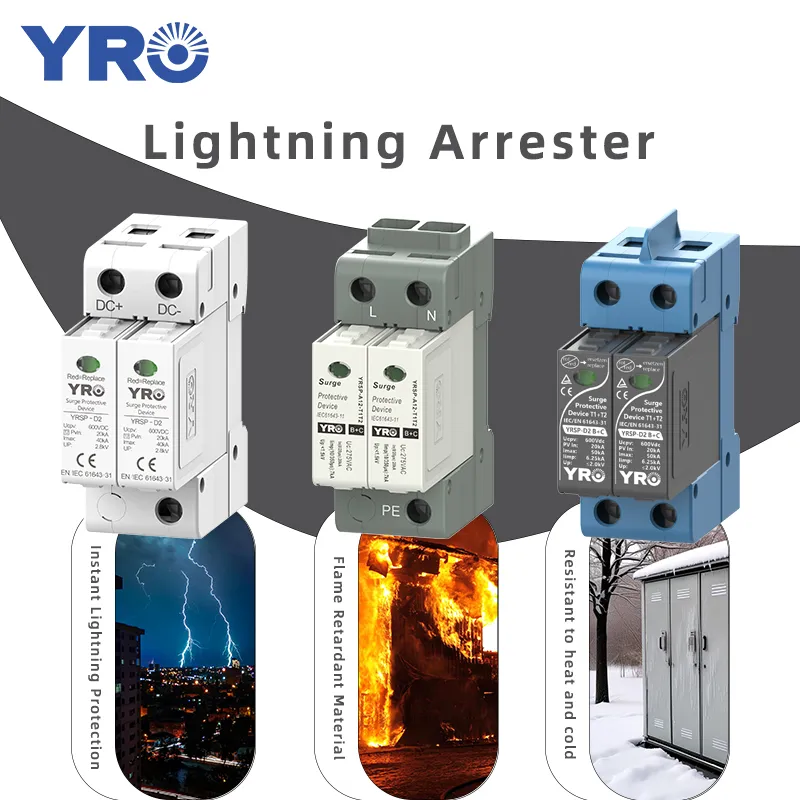What Can a Surge Arrester Do That a Circuit Breaker Can't?
2025-05-24
Modern power systems are threatened by transient voltage surges. These short, high amplitude voltage pulses, usually lasting from nanoseconds to milliseconds, caused by lightning strikes, grid fluctuations or the switching of industrial equipment, can silently destroy precision electronic devices ranging from laptops to photovoltaic inverters. Although circuit breakers are crucial for preventing overloads and short circuits, they are powerless against microsecond-level surges that bypass their mechanical tripping mechanisms. This article will delve into the functions that lightning arresters can perform but circuit breakers cannot, as well as why both are indispensable in electrical protection.
What Can a Surge Arrester Do That a Circuit Breaker Can't?
Both lightning arresters and circuit breakers are protective devices in power systems, but they have essential differences in functional positioning, working principles and application scenarios.
A surge arrester uses nonlinear components, such as metal oxide varistors (MOV) to conduct overvoltage into the ground within nanoseconds, thereby protecting electronic devices from instantaneous voltage spikes (such as lightning strikes) - something that circuit breakers cannot handle. In contrast, circuit breakers only cut off the power supply when there is a continuous overcurrent (such as overload or short circuit), and are unable to respond to microsecond-level surges. Surge arresters protect equipment and circuit breakers protect lines.

Why Can't Circuit Breakers Replace Surge Arresters in Lightning Protection?
Many people want to use circuit breakers instead of lightning arresters to save money, but this is impossible. Why is that? Just read the following content and you will know.
1. Fundamental Differences in Protection Targets
As mentioned above, lightning arresters are specifically designed to suppress transient overvoltage, while circuit breakers only operate in response to abnormal currents (overload or short circuit).
2. Absence of Nonlinear Characteristics
The surge arrester adopts nonlinear resistance materials such as zinc oxide (ZnO), which present a high resistance state (>1MΩ) under normal voltage. However, when the voltage exceeds the threshold, the resistance drops sharply to <1Ω, forming a low-impedance discharge channel. This nonlinear characteristic is not possessed by circuit breakers.
3. Response Time Disparity
- Lightning arrester: Nanosecond-level response, matching the time before the lightning wave (1-5μs), and can complete clamping during the voltage rise stage.
- Circuit breaker: The fastest operating time is in milliseconds, which is much slower than the duration of lightning strikes. When the circuit breaker reacted, the lightning current had passed through the equipment and caused damage.
4. System Recovery Mechanism After Action
After the surge arrester discharges the lightning current, the nonlinear resistor immediately returns to the high-resistance state, and the system can continue to operate without interruption. Once a circuit breaker trips, power supply must be restored through manual or automatic reclosing, resulting in a power interruption. In areas with frequent thunderstorms, such interruptions may occur repeatedly due to multiple lightning strikes, seriously affecting the reliability of power supply.
Where Should Surge Arresters Be Installed That Circuit Breakers Can't Reach?
1. Circuit Breaker Contact Gaps (Open State)
When the circuit breaker is in the open state, an insulating gap is formed on both sides of its break. At this time, the lightning wave or operational overvoltage may undergo total reflection at the break, causing the voltage amplitude to double. A lightning arrester can be installed on the line side of the break to limit the reflected overvoltage.
2. Sections of Overhead Lines with High Lightning Strike Risk
Because circuit breakers can only cut off short-circuit currents but cannot intercept the propagation of lightning waves on conductors, surge arrester can be installed on the conductors of poles and towers, on overhead lines with frequent lightning activities or complex terrain.
3. Both Sides of the Frequently Opened and Closed Contact Switch
When a connecting switch (such as a pole-mounted circuit breaker or disconnector) opens, the live side line is exposed to the risk of lightning wave intrusion, and the circuit breaker cannot provide break protection. Therefore, for connecting switches that are often in a hot standby state, a lightning protection devices needs to be installed on the live side.
4. Low-Voltage Side of the Distribution Transformer
After the lightning waves invade through the high-voltage side, they may couple to the low-voltage side through electromagnetic induction, generating transient shocks several times the rated voltage. The electrical surge arrester on the low-voltage side needs to form multi-level coordination with the high-voltage side, to ensure that the residual voltage is lower than the equipment's tolerance value.
Conclusion
Surge arresters and circuit breakers are not in a substitutive relationship but rather complement each other. Circuit breakers are responsible for controlling overcurrent, while lightning arresters handle instantaneous overvoltage. To comprehensively protect equipment and facilities, both are indispensable. Understanding their respective functions and limitations is the key to building a safer and more reliable electrical system.




